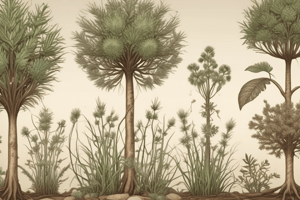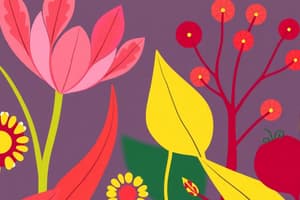Podcast
Questions and Answers
What is the primary use of juniper berries?
What is the primary use of juniper berries?
- They are used as a spice and in alcoholic drinks. (correct)
- They are mainly consumed as fruits.
- They are used for wood construction.
- They are primarily used for decorative purposes.
Which of the following species is considered the tallest tree in the world?
Which of the following species is considered the tallest tree in the world?
- Coastal redwood (correct)
- European larch
- Northern white-cedar
- Giant sequoia
Which tree has needles that are dark green and grow in bundles of two, measuring 10-15 cm long?
Which tree has needles that are dark green and grow in bundles of two, measuring 10-15 cm long?
- Norway spruce
- Blue spruce
- Scots pine
- Austrian pine (correct)
What is a unique characteristic of the European silver-fir's cones?
What is a unique characteristic of the European silver-fir's cones?
Which family do Dwarf mountain-pine and Scots pine belong to?
Which family do Dwarf mountain-pine and Scots pine belong to?
What characteristic identifies the Yew family of plants?
What characteristic identifies the Yew family of plants?
Which tree species has poisonous seeds and is generally considered barely toxic?
Which tree species has poisonous seeds and is generally considered barely toxic?
Where is the Cedar-of-Lebanon native to?
Where is the Cedar-of-Lebanon native to?
What is one primary advantage that seeds have over spores?
What is one primary advantage that seeds have over spores?
What defines a gymnosperm?
What defines a gymnosperm?
Which of the following best describes the life cycle of gymnosperms?
Which of the following best describes the life cycle of gymnosperms?
What happens after fertilization in gymnosperms?
What happens after fertilization in gymnosperms?
Which characteristic is true for the gymnosperm group known as cycads?
Which characteristic is true for the gymnosperm group known as cycads?
What unique characteristic does the Ginkgo biloba plant possess?
What unique characteristic does the Ginkgo biloba plant possess?
What is a common feature of conifers within the Pinales order?
What is a common feature of conifers within the Pinales order?
How do gymnosperms primarily achieve pollination?
How do gymnosperms primarily achieve pollination?
Which statement about seeds is NOT accurate?
Which statement about seeds is NOT accurate?
Flashcards
Juniper Berry
Juniper Berry
A type of fruit found in the Juniper family, formed by the fleshy cone of the plant. Often used as a spice or in the production of certain alcoholic drinks.
Scots Pine
Scots Pine
A tall, evergreen tree known for its needle-like leaves arranged in bundles of two.
European Silver Fir
European Silver Fir
A tall, evergreen tree with large, upright cones and flat needles that have two distinctive white bands on the underside.
European Larch
European Larch
Signup and view all the flashcards
Aril
Aril
Signup and view all the flashcards
Northern White-Cedar
Northern White-Cedar
Signup and view all the flashcards
Cedar of Lebanon
Cedar of Lebanon
Signup and view all the flashcards
Coastal Redwood
Coastal Redwood
Signup and view all the flashcards
Giant Sequoia
Giant Sequoia
Signup and view all the flashcards
Seed Plants
Seed Plants
Signup and view all the flashcards
Flowers or Cones
Flowers or Cones
Signup and view all the flashcards
Gymnosperm
Gymnosperm
Signup and view all the flashcards
Angiosperm
Angiosperm
Signup and view all the flashcards
Spore
Spore
Signup and view all the flashcards
Cycad
Cycad
Signup and view all the flashcards
Ginkgo
Ginkgo
Signup and view all the flashcards
Pine
Pine
Signup and view all the flashcards
Pollination
Pollination
Signup and view all the flashcards
Fertilization
Fertilization
Signup and view all the flashcards
Study Notes
Seed Plants
- Seed plants have seeds, reduced gametophytes (ovules and pollen), and create flowers (or cones) and fruits.
Advantages of Seeds over Spores
- Seeds are multicellular, consisting of an embryo and food supply.
- Seeds are protected by a seed coat, allowing dormancy for days, months, or even years.
- Seeds can be dispersed by wind or animals over long distances.
- Seeds germinate more easily than spores.
- Spores are single-celled and lack protection from harsh conditions, with shorter lifespans.
- Spores require a wet environment to germinate.
Changes after Fertilization
- The zygote divides and forms an embryo.
- The ovule transforms into a seed.
- The female cone develops into a woody cone.
Divisions of Seed Plants
- Gymnosperms (naked seed plants)
- Angiosperms (covered seed plants)
Gymnosperms
- Two divisions: Gymnosperms (nahosemenné rastliny) and Angiosperms (krytosemenné rastliny).
- Seeds are "naked," meaning they are on scales of woody cones (šišky).
- Ovules are not protected by an ovary.
Gymnosperm Life Cycle
- Sporophyte is the recognizable plant.
- Separates male and female cones (strobili, šištice).
- Male cones contain pollen grains.
- Female cones create ovules.
- Male gametophyte = pollen grain (contains sperm).
- Female gametophyte = ovule (contains two egg cells).
Gymnosperm Pollination and Fertilization
- Rely on wind for pollination.
- The pollen grain lands on the female cone, forming a pollen tube for sperm cell travel to the egg cell.
- Fertilization creates a diploid zygote; unlike angiosperms, double fertilization does not occur.
Gymnosperm Families
- The cycad order (CYCADALES – CYKASY): palm-like, dioecious, up to 20 meters high. Queen Sago (cykas indický) seeds contain starch (sago) for use as flour.
- The maidenhair-tree order (GINKGOALES – GINKÁ): only living ginkgo species, fan-shaped leaves, dioecious, oldest fossils date back 270 million years, used as a park tree, pharmaceutical purposes.
- The pine order (PINALES – IHLIČINY): conifers, evergreen needle-like or scaly leaves, resin canals, monoecious, wind-pollinated. Includes cones, berries, and aril. Specific types include Scots pine, Austrian pine, dwarf mountain-pine, Norway spruce, blue spruce, European silver-fir, European Larch.
Specific Conifers
- Information on different types of conifers, including their features (needle shape, cone shape, height, etc.), location, uses, etc. (e.g., Coastal redwood, Giant sequoia, Juniper, Cedar-of-Lebanon, Yew).
Studying That Suits You
Use AI to generate personalized quizzes and flashcards to suit your learning preferences.




